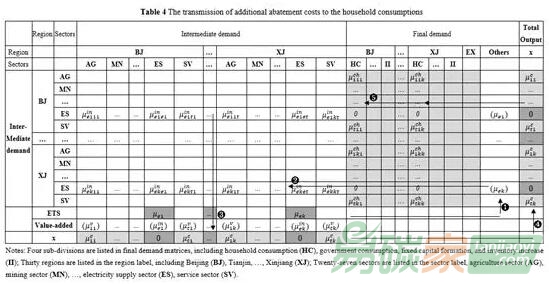Modeling the cost transmission mechanism of the emission trading scheme in China
Ju Yiyi1*, Fujikawa Kiyoshi2
1 Graduate School of InternationalDevelopment, Nagoya University, Nagoya 464-8601, Japan
2 Applied Social System Institute of ASIA, Nagoya University, Nagoya 464-8601, Japan
Highlights
The transmission mechanism of emission abatement cost brought by ETS is modeled;
Rises in household consumption would occur in net emission importer cities;
Such rises would be brought by the emissions embodied in other sectors rather than the ETS covering sector.
The increase rate of the rises in household consumption in most sectors (745 of the 810) would be below 0.1%.
There is still room for the ETS market price to be further increased.
摘 要
2017年底,全國(guó)
碳排放交易
市場(chǎng)宣布啟動(dòng)第一階段,僅覆蓋
電力供應(yīng)部門(mén),并預(yù)計(jì)將在2020年正式運(yùn)行。在現(xiàn)階段,被8個(gè)試點(diǎn)市場(chǎng)覆蓋的供電企業(yè),正面對(duì)著不同區(qū)域在
減排成本和環(huán)境規(guī)制上的差異。這種差異是導(dǎo)致國(guó)內(nèi)區(qū)域間的碳泄漏的重要原因,會(huì)降低
碳交易市場(chǎng)
政策的減排成效,也會(huì)引起居民消費(fèi)不同幅度的上升。尤其在中國(guó),上網(wǎng)電價(jià)、居民用電及工業(yè)用電獨(dú)立定價(jià),且電力市場(chǎng)化發(fā)展尚未成熟,從宏觀角度看,供電單位(生產(chǎn)者)無(wú)法將由
碳市場(chǎng)帶來(lái)的額外減排成本自動(dòng)傳導(dǎo)至用電單位(消費(fèi)者),此部分直接減排成本僅有生產(chǎn)者全部負(fù)擔(dān)。考慮到電力行業(yè)的這一特點(diǎn),本文基于2012年區(qū)域間電力部門(mén)隱含碳排放流動(dòng),建立了中國(guó)碳市場(chǎng)成本傳導(dǎo)機(jī)制模型,以揭示不同碳市場(chǎng)場(chǎng)景下,居民消費(fèi)不同幅度的上升。結(jié)果顯示,試點(diǎn)城市為隱含碳排放的凈進(jìn)口城市,包含了直接進(jìn)口(來(lái)自其他區(qū)域的電力供給)與間接進(jìn)口(來(lái)自其他區(qū)域的其他行業(yè)的電力使用)。居民消費(fèi)受到碳市場(chǎng)影響較大部門(mén)的有,金屬礦物采選部門(mén)-
河北(10.1%)、汽油與煤氣供應(yīng)部門(mén)-
黑龍江(9.9%)以及非金屬礦物采選部門(mén)-
四川(3.5%)。然而,大部分部門(mén)(745/810)的增長(zhǎng)幅度低于0.1%,本文認(rèn)為,在居民消費(fèi)的價(jià)格穩(wěn)定性得到保障的前提下,目前的碳市場(chǎng)平均市場(chǎng)價(jià)格有進(jìn)一步上升至指導(dǎo)價(jià)格的空間。
Abstract
The national emission trading scheme (ETS) in China, CHN-ETS, was established in 2017 following the start of its regional pilot markets in 2013. It will start with a coverage of electricity supply sector and eight pilot regions. Due to a highly regulated dispatch and pricing system in the electricity supply sector, the additional emission abatement costs brought by the ETS cannot be automatically conveyed between consumers and producers in all regions. This paper modeled the cost transmission of ETS in three scenarios based on the quantification results of regional and sectoral emission flows in the electricity supply sector under consumption-based accounting. The results show that the emissions transferred into pilot cities outweighed the emissions transferred out, not only through direct electricity uses but also through the indirect emissions embodied in other sectors that required intermediate inputs from electricity supply sectors in the pilot cities. Through the cost transmission mechanism, the additional abatement cost caused by the national ETS drove the increases in the household consumption of several energy-intensive sectors, including the metal mining sector in Hebei, the petroleum and gas sector in Heilongjiang, and the nonmetal mining sector in Sichuan, with a sensitive increase of 10.1%, 9.9%, and 3.5%, respectively. However, most sectors (745 of the 810) would suffer an increase rate below 0.1%. As long as the household welfare would be ensured, there is still room for the current average market price in the pilot cities to be further increased toward the official guidance price in the nation-wide market.
Keywords:Consumption-based emissions, cost transmission, emission trading scheme, pilot cities.
金屬質(zhì)感分割線
分割線 箭頭 動(dòng)態(tài)
Table 4. The transmission of additional abatement costs to the household consumptions









